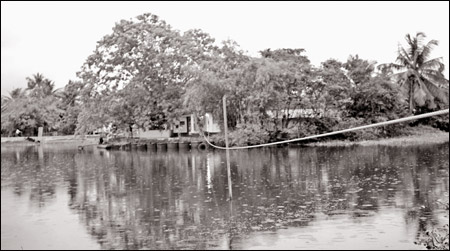Saving our water
Disna Mudalige
In the present era, the water pollution caused by releasing
wastewater from industries directly to waterways is a major issue of
concern in Sri Lanka. Specially the textile waste water containing dye
and industrial wastewater containing organic materials have raised many
environmental and health problems. Due to the consumption of these
contaminated water, the extinction of fish and other kinds of species
living in water is reported time to time in many parts of the country.
|

Aaquatic life of Lunawa lagoon has been degraded due to
continued discharge of wastewater. File photo |
Not only fish, but also the birds which hunt fish are also affected
by this. This shows the degree of disturbance human activities cause to
the natural cycle of the nature.
Kelaniya River, Beira Lake, Bolgoda Lake and Lunawa lagoon are
visible examples for the water pollution by human activities. The
aquatic life of the Lunawa lagoon has been degraded due to continued
discharge of wastewater into its tributaries. The lagoon is now devoid
of aquatic life and considered to be biologically dead.
Wastewater disposal
As recorded a considerable number of people use rivers and tanks to
get drinking water. The safety of these means for drinking water
purposes is becoming hazardous day by day. Most of these rivers are also
being used by the general public for various purposes such as washing
and bathing etc.
Among major illnesses of water pollution, typhoid/paratyphoid fever,
shigellosis, food poisoning, amoebiasis, intestinal infections, malaria
and dengue fever are reported to be quite common. As Central
Environmental Authority (CEA) Environmental Protection Director Ramani
Ellepola brings out in her paper ‘Implemention of Industrial Pollution
Control Programs in Sri Lanka’, the industries which generate the
largest quantities of wastewater in Sri Lanka are the textile, natural
rubber processing and food processing industry sectors.
These three industry sectors are widely distributed throughout the
country. The effluents generated from these industries are generally
disposed into nearby water bodies such as rivers, lakes or into the
ocean, due to the lack of a proper system for the disposal of
wastewater.
Irrigation purposes
The National Environmental Act No: 47 of 1980 with amendments Act No:
56 of 1988 lays down that, ‘no person shall pollute any waters of Sri
Lanka or cause or permit to cause pollution in the inland waters of Sri
Lanka’. Understanding the seriousness of the issue general standards
have been laid down by CEA for the discharge of effluents into inland
surface waters.
As Ellepola discribes industrial effluent standards are as follows:
a. General standards for discharge of effluents into inland surface
waters.
b. Tolerance limits for industrial effluents discharged on land for
irrigation purposes.
c. Tolerance limits for industrial and domestic effluents discharged
into marine coastal areas.
d. Tolerance limits for effluents from rubber factories discharged
into inland surface waters.
e. Tolerance limits for effluents from textile industry discharged
into inland surface waters.
f. Tolerance limits for effluents from tannery industry.
These are included in the Environment Impact Assessments and
Environmental Protection Licence. All new industries as well as the
existing industries are encouraged and recommended to establish central
treatment plants within them.
As a good solution to the existing problem of wastewater disposal in
the country University of Moratuwa Chemical and Process Engineering
Department senior lecturer Padma Amerasinghe has designed a waste
biomass for the removal of heavy metals from wastewater. This biomass
can be operated by using rice husk, saw dust, tea waste or choir pith,
which are called solid absorbents. Dyes and industrial wastewater can be
cleaned in this way.
The liquid is sent through an absorption column with a perpetrated
bottom filled with one of the solid absorbents. In the process, the dye
component will be transformed to the solid material.
Natural waterways
As Dr Amerasinghe mentioned, 1,000 liters of wastewater containing
roughly 30 milligrams of dye per liter can be cleaned by using five
kilograms of rice husk. The water coming out of this system is checked
with the COD and BOD standards, and results are within the possible
limits of these standards. The outcome is safe to release to natural
waterways. She suggested to burn the used solid absorbent to get energy,
and further said that the ashes can be used in cement.
She also mentioned that better results can be acquired if this method
is coupled with other established methods to clean water such as
coagulation. In that way, less quantity of solid can be used as well.
It should be noted that innovative methods like the above must be
given serious consideration and attention, as a means to reduce the
existing water pollution in the country. |



